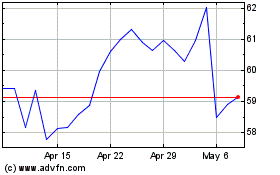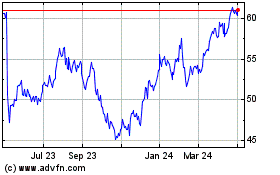Supreme Court Likely to Uphold Wage Suit Against Tyson Foods
November 10 2015 - 4:00PM
Dow Jones News
WASHINGTON—The Supreme Court appeared ready Tuesday to uphold a
$5.8 million judgment against Tyson Foods Inc. for underpaying
workers at an Iowa pork plant, likely frustrating business hopes
for another blow against class-action litigation.
"I just don't understand your arguments," Justice Anthony
Kennedy told Tyson's lawyer as the hearing began. As the hour
unfolded, Justice Kennedy sketched out his view the court's ruling
should focus on specific provisions of labor law favoring employees
when businesses don't keep track of hours worked, rather than on
class-action principles.
The case came from Storm Lake, Iowa, where workers alleged Tyson
didn't' pay them for their time when applying protective gear and
walking to the slaughterhouse floor. Such "donning and doffing" and
"walking time" cases are common labor disputes, and the Supreme
Court has decided several on narrow grounds in recent years.
The Tyson case was different, however, because the central issue
was the use of statistical estimates to establish liability,
potentially affecting a wide range of class actions in different
industries.
Because Tyson didn't keep accurate hourly records, lawyers for
the workers used statistical experts to estimate the average
underpayment. The estimates were based on "744 videotaped
observations" of how workers spent their time, the plaintiffs'
lawyer, David Frederick, told the court.
Tyson's lawyer, Carter Phillips, said the approach improperly
averaged the hours of employees who performed "vastly different
activities" and spent varied amounts of time donning and doffing,
from 30 seconds to 10 minutes.
Under those estimates, more than 200 employees included in a
class of more than 3,000 workers potentially could receive
compensation even though they didn't' work overtime, Mr. Phillips
said. Several justices suggested such matters could be resolved by
the trial court when it divvies up the judgment.
Recent Supreme Court decisions have tightened the reins on
class-actions, requiring plaintiffs' attorneys to more clearly show
the victims they purport to represent truly share the same
circumstances and injuries.
In a 2011 case, Wal-Mart Stores Inc. v. Dukes, the court threw
out a suit seeking to represent 1.5 million women who allegedly
suffered sex discrimination by the retailer. The court found
statistical evidence regarding disparities between male and female
employees inadequate to demonstrate the "commonality" of interests
among the class. In Dukes and a 2013 antitrust case that likewise
rejected a class action, Justice Kennedy joined four conservatives
in the majority, while the four liberal justices dissented.
Business interests hoped the Tyson case would make a triad of
rulings requiring plaintiffs' attorneys to demonstrate each member
of a class actually suffered damages, rather than relying on
projections.
Justice Antonin Scalia, who wrote both of the prior pro-business
precedents, appeared most open to Tyson's arguments.
When Mr. Frederick said the workers all wore similar sanitary
gear, Justice Scalia said that wasn't the full story.
"Some of them wear, what, chain mail to protect them from the
knives, right?" he said. "Some of them wear other protective gear.
And that's what is claimed to create the discrepancy," he said.
Unlike the two prior cases, the Tyson suit was brought under the
Fair Labor Standards Act of 1938, which spells out rules for
overtime pay. Several justices observed that a 1946 precedent,
Anderson v. Mount Clemens Pottery Co., involved circumstances
similar to those in the Tyson case—a dispute regarding overtime pay
with an employer that failed to keep hourly records.
The precedent suggests "that certain kinds of statistical
evidence are completely appropriate" in wage and hour cases,
Justice Elena Kagan said.
Justice Kennedy agreed, but added he would subject statistical
evidence in class actions to greater scrutiny if presented outside
the special provisions of labor law.
Chief Justice John Roberts appeared concerned a ruling for the
workers could expand the use of statistical evidence more broadly,
at least in wage cases.
"You agree it would be an extension of Mount Clemens to apply it
at the liability stage as opposed to the damages stage, right?" he
told Justice Department attorney Elizabeth Prelogar, referring to
the 1946 case. The government argued in favor of the workers'
position.
Ms. Prelogar said the Mount Clemens case supported such use of
statistics because the ruling "recognized at the outset that the
burden of proving that you have performed work for which you were
not properly compensated shouldn't be an 'impossible burden."
Write to Jess Bravin at jess.bravin@wsj.com
Subscribe to WSJ: http://online.wsj.com?mod=djnwires
(END) Dow Jones Newswires
November 10, 2015 15:45 ET (20:45 GMT)
Copyright (c) 2015 Dow Jones & Company, Inc.
Tyson Foods (NYSE:TSN)
Historical Stock Chart
From Jun 2024 to Jul 2024

Tyson Foods (NYSE:TSN)
Historical Stock Chart
From Jul 2023 to Jul 2024
